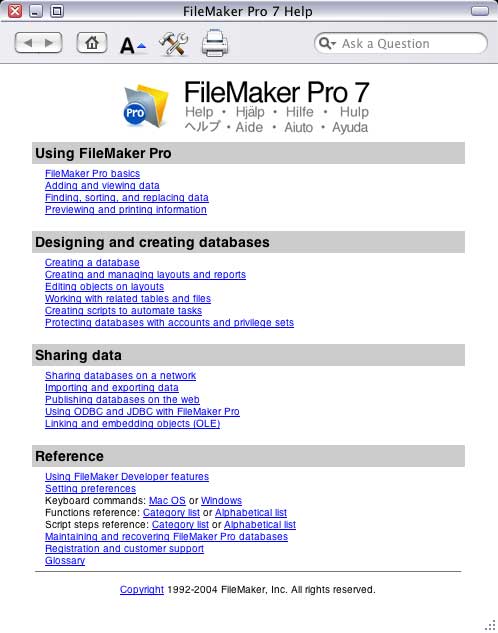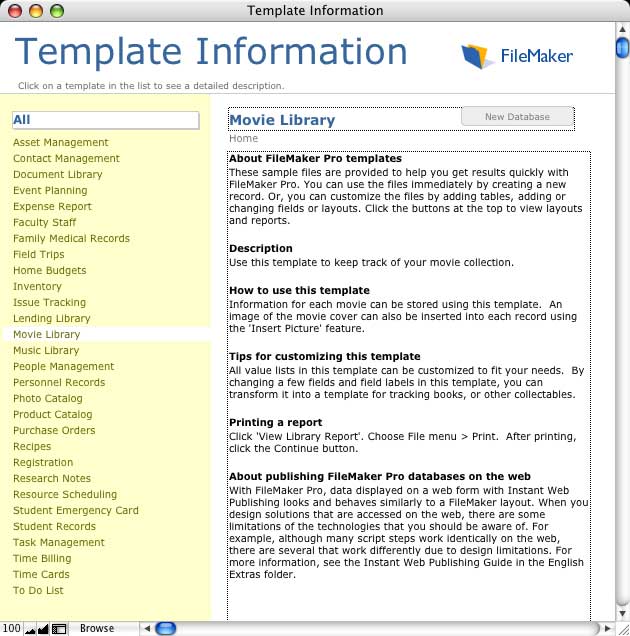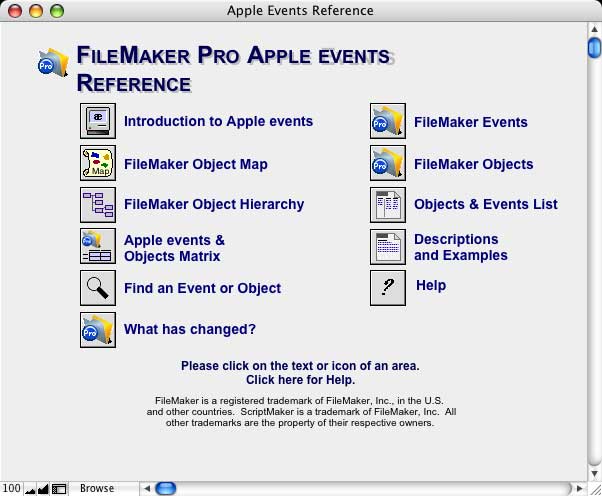FileMaker Pro Session 2FileMaker Pro & Supporting FilesFileMaker Pro HelpThe FileMaker Pro Help is a new feature. It is called QuickHelp and is a document and an application. It will allow you to type in a subject and it will go exactly to that area. So, in effect, it is another type of tutorial. Keith prefers it over the tutorial because he can quickly find a formula or layout tools. It will go right to it just by typing it in. The help program is excellent. Double-click on it. Go up to the top. Guess what you need to type in. For example, "sum" and immediately the word "function" appears in gray. Below it will go to the right area. We can click on a phrase or word below and it goes right to that area (like going to a page on the World Wide Web by clicking on a link.) If you click on a blue underlined word, it creates a balloon which allows you to see in detail what that word is. This is really an easy way to find information and solve your problems. FileMaker Pro Help launches automatically when you launch any FileMaker Pro document. Go under the Apple Menu and chose FileMaker Pro Help. In Filemaker 7 the online help is more complete than the documentation, just choose Filemaker help from the help menu
Then we have FileMaker Pro extensions. Leave these alone. Absolutely do nothing with these files because these are what talk to other files like ClarisWorks and other databases (say DOS and Windows.) TCP/IP Network is for networking (internet-type things.) The Mac IPX Network is used when you are using cross-platform files (Windows to Mac) linked with the Novell system. FileMaker Pro Examples includes Integrated Solutions. If you want to save hundreds of hours of programming, you can go in here and actually create an invoice system using predefined information that Claris has taken the courtesy and time to create for you. We can go into the Templates folder and let’s say that I don’t really want to take the time to learn how to create all these files. So, if I’m running a golf club, I can just click on Club Membership and it already has the fields and calculations defined (the information you need.) They have created different types for home, school and business. Take the time to go through these. There are hundreds of different examples here that will save you literally hundreds of extra hours creating databases.Then we have the FileMaker Pro Templates. Some of these are actually repeated in here (from FileMaker Pro Examples. FileMaker Pro TemplatesWe have them for home as well as for business, so we can keep track of our checkbook, budget, medical records. It’s really handy. They took the time and trouble to give them to you. Leave them on there. In filemaker 7 there is now a database of starter files:
Starting a new fileYou can create as many database files as you need to organize information. You can create a file when you start FileMaker Pro or after the application is open. To create a FileMaker Pro file:
Note If you do not have the preference set in the Document area of the Preferences dialog box to Show templates in New File dialog box (or you don't have the templates installed), you don't see the New Database dialog box. Instead, type a file name in the dialog box and click Save.
FileMaker Pro& Apple EventsYou can link an Apple application called AppleScript and it will allow you to work with apple events going into (linking with) another application (such as Excel or PageMaker.) There are sample files here also (e.g., Applet) It lets FileMaker Pro talk to another application using Apple Script as a go-between so it looks like you never left FileMaker Pro but you really did. Using Apple Events Apple events let you automate, customize, and control many Macintosh applications. FileMaker Pro can send Apple events to applications that support them. FileMaker Pro can also receive Apple events from applications that have been designed to send Apple events. Use the Send Apple Event script step in ScriptMaker Pro to send Apple events from FileMaker Pro to other applications. Apple events are grouped into suites. FileMaker Pro supports the following:
A complete reference for Apple event support, containing almost 60 pages of information is available with your FileMaker Pro product. Refer to the file named FileMaker Apple Events in the Apple Events Scripting folder for a complete description of all FileMaker Pro events and objects along with many examples and usage tips. Note FileMaker Pro now supports a subset of the URL Suite. In filemaker 7 the Applescript features are detailed in, what else, a database:
|
Jump Menu |



